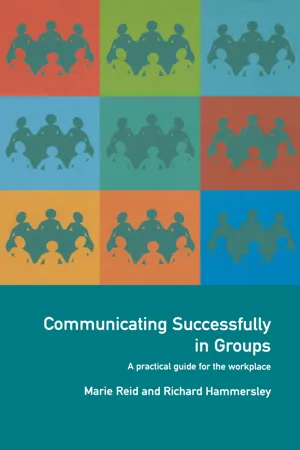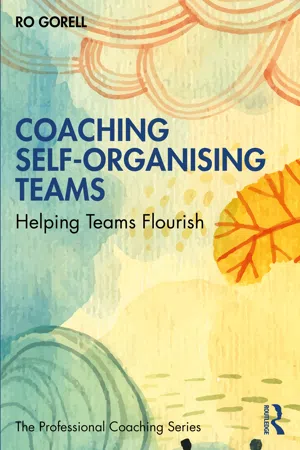Business
Group vs Team
A group is a collection of individuals who come together for a specific purpose but may not necessarily have a shared goal or interdependence. A team, on the other hand, is a cohesive unit of individuals working together towards a common goal, with a high level of interdependence and collaboration. In a business setting, teams are often more effective in achieving complex tasks and goals compared to groups.
Written by Perlego with AI-assistance
Related key terms
Related key terms
1 of 4
Related key terms
1 of 3
10 Key excerpts on "Group vs Team"
- eBook - ePub
- Haukur Ingi Jonasson, Helgi Thor Ingason(Authors)
- 2018(Publication Date)
- Routledge(Publisher)
organisation is a more permanent entity where a number of individuals co-operate to achieve ongoing success, such as in business, and whose lifespan is greater than that associated with individual projects.To sum it up, a team is therefore a group that works consciously and purposefully together towards meeting common goals and objectives. Project teams work on a certain task or tasks within a defined structure that includes variables such as cost, time, and any other special attributes unique to that project. The word “task” is used here in relation to projects in the sense of being “a unique series of interconnected components that have one goal and one purpose. A task needs to be completed within a certain time, according to budget and in accordance with the specified description of the project” (Wysocki et al ., 2000).Classical studies of social psychology, which we reference heavily here, have a direct bearing for understanding team dynamics and their performance. In physics, the word dynamics refers to the movement of objects due to the forces that act upon them. While interactions between inanimate moving objects have clear physical laws that can be used to determine outcomes, there is less certainty in the case of interpersonal interactions although management experience in this area has shown a number of clear trends that have predictive value. Team dynamics, therefore, relates to the interactions between individuals and the associated events that follow. We will use the term team dynamics to mean the behavioural relationships between members of a group that are assigned connected tasks. This will mean both the behaviour of individual team members when they are influenced by the team and the collective behaviour of a team within its environment. In this book, we discuss team dynamics and team communication - eBook - ePub
The Hedgehog Effect
The Secrets of Building High Performance Teams
- Manfred F. R. Kets de Vries(Author)
- 2011(Publication Date)
- Wiley(Publisher)
Alexandre Dumas’s fictional 17th-century adventure remains an effective prescription for our third millennium workplace; the underlying, out-of-awareness psychodynamic individual and team processes of his musketeers were aligned with the task at hand. Helping to create this kind of team is one of the over-arching objectives of executive and leadership group coaching.TEAMS: WHAT, WHY, AND HOW Before discussing teams, let’s first specify the difference between a group and a team. A group is any number of individuals who form a recognizable unit, cluster, or aggregation.Teams are specific groups of people with (it is hoped) complementary skills and abilities who join together to collaborate. People in a team possess a high degree of interdependence geared toward the achievement of a common goal or completion of a task for which they hold one another mutually accountable. In contrast to most groups, teams often identify and reach an agreement on their common goals and approaches, rather than looking to a leader to define them. What’s more, the outcome of a team’s activities will affect team members as a whole, not just each member individually. In the organizational context, team members are empowered to share responsibility for specific performance outcomes, and work together for a limited period of time. The most effective size for teams is between five and 12 people. Larger teams require more structure and support, while smaller teams often have difficulty engaging in robust discussions when members are absent [1–7]. (As groups and teams essentially differ depending on the degree and intensity of interdependence, throughout this book these two terms will be used interchangeably).Are you a part of a team or do you merely belong to a group of people? Study the following questions and answer them either YES or NOYES NO 1. Do the people you work with have a high degree of interdependence, geared toward the achievement of a common goal or completion of a task for which they hold themselves mutually accountable? 2. Do you belong to a group of people with complementary skills and abilities who come together to collaborate? 3. Does the outcome of your activities affect not merely you, but all the other people you work with? - eBook - ePub
Communicating Successfully in Groups
A Practical Guide for the Workplace
- Richard Hammersley, Marie Reid(Authors)
- 2014(Publication Date)
- Routledge(Publisher)
Modern life is full of lots of things called teams such as Telephone Sales Teams; Management Teams; Quality Assurance Teams; Food Services Teams; Surgical Teams; Social Work Teams; Community Psychiatric Teams; Drug Action Teams. All of these, or the many other groups called teams, lose their right to be called teams if they don’t interact properly, or share common goals. Many work groups which would resent being renamed teams may well function as teams. From here on, we will be using ‘team’ in a technical sense, to refer to a workplace group with certain positive characteristics.So what is a team? A team is a group of people at work who:- Work together regularly towards agreed common goals.
- While in the team, regard their team identity as a main feature of their workplace identity.
- Who have largely open communication among themselves.
- Are in the team because of their individual characteristics, although some teams are formed out of whoever is available.
- Who usually adopt a variety of different roles within the team.
Nature of teams
As with group development there is also a growing emphasis on the importance of team building and team development in the workplace. This is particularly the case in large businesses and commercial organisations, where more and more people consider effective teamwork to be the thing of the future. Hence the move towards a greater emphasis on teamwork in the workplace, although there has recently been a backlash questioning whether teams actually work in practice. Our view is that teams are hard to build and easy to damage. The failure of teams to deliver reflects these difficulties, but the ideal of the effective team is still worth working towards. By this stage in this book you should appreciate that we have to work in groups whether we like it or not and there is no real alternative to trying to develop effective workplace groups. A team is an effectively-functioning group.Permanence of teams
Teams may be formed for particular tasks, disbanding when the task is over. Some companies encourage this sort of flexibility; well-known examples include W. L. Gore (manufacturers of Gortex) and Microsoft. Or teams may be permanent and work on a number of tasks of different kinds over the years. Long-established teams may come to get along extremely well and work effectively together. However, they may also become stale, resistant to change and inward-looking. They may shut out the outside world. Long-established team members may also come to attribute their success to unique personal characteristics. For example, they may regard the charisma of their leader as essential. If key people leave, then the team may no longer function effectively. - eBook - ePub
Coaching Self-Organising Teams
Helping Teams Flourish
- Ro Gorell(Author)
- 2021(Publication Date)
- Routledge(Publisher)
If there is little interdependence and collective accountability, and no shared purpose, the organisation likely creates a group of people rather than a team. Again, a simple definition of a group is a collection of people who report to the same function or manager. In organisational terms, this is usually the reporting line on an organisation chart. The link between the individuals is merely the fact that they report through the same structure with individual accountabilities and contributions. The exception to this might be at the senior executive level. Typically, executive team members have discrete responsibility for a business unit and collective responsibility to deliver business-wide results. Delivering business-wide results does not necessarily mean that the executive team will be a real team – given the explanation earlier about complexity, it is increasingly likely that more executive teams will now have to function as real teams (Wage-man et al. 2008).Table 1.1 Prerequisites for Real TeamsPrerequisite Shared purpose What are we here to do? What are the outcomes we are seeking to achieve? Why does that matter? Interdependency What can only be done by collaborating? What can be done individually? What additional outcomes will be achieved by working together? Collective accountability What must we achieve together? How often will we review progress? What will happen outside of meetings? What will happen if one individual does not meet the requirements? Drive to improve What time will be spent on reflecting on progress and learning? How will the learning be applied to future work together? What level of willingness is there to allow space for reflection? What constitutes a team and team effectiveness elide in most research. Hack-man (2002) expounds five conditions for team effectiveness, and we can see some overlap with the themes mentioned earlier on defining teams: - eBook - ePub
- Paul Smith, Marilyn Farmer, Wendy Yellowley(Authors)
- 2013(Publication Date)
- Routledge(Publisher)
The CIPD (2011) defines a team as a ‘limited number of people who have shared objectives at work and who co-operate, on a permanent or temporary basis, to achieve those objectives in a way that allows each individual to make a distinctive contribution. From this definition we can see that key aspects of team-working are:• shared objectives, which assumes that everyone has had a say in and a chance to create agreed goals• cooperation, which is necessary for effective team-working• making a distinctive contribution – utilizing the diverse set of skills and experience of team members• a limited number of people – the ideal number of people to make up an effective team has been the focus of much research.Clegg, Kornberger and Pitsis (2005) also introduced the concept of collective responsibility, and suggest that a team differs from a group in that individuals are more ‘psychologically’ aware of each other and become interdependent. This is an important point, as the key aspect of being a member of a team is the emotional link and commitment to common goals. So while a group of people waiting in a queue to see the latest rock band all have a common purpose, they would be classified as a group of individuals and not a team. In contrast, a football team has a fixed number of players, everyone has a role and a contribution to make, and co-operation is critical to achieving the shared objective.Other authors introduce additional perspectives of a ‘team’. Kozlowski and Bell (2003), for example, refer to the organizational context in which the team operates, which will influence, constrain and impact on the way the team-members work together. Factors such as location, resources and technology will all play a part in how the team operates.KEY TERM Team:a group of people who work together and have shared goals, cooperating and working towards achieving their goals.5.3 Why are teams important?
In Chapter 10 - eBook - ePub
Management Skills in Schools
A Resource for School Leaders
- Jeff Jones(Author)
- 2004(Publication Date)
- SAGE Publications Ltd(Publisher)
‘Establishing a mission … giving a sense of direction’ (Louis and Miles, 1992) ‘Being taught by the organisation’ (Hodgson, 1987) ‘Learning from the organisation’ (Hodgson, 1987)Table 2.2 Leadership, management and administration in schools (based on Law and Glover, 2000)Point for reflection
What distinctions do you draw between leadership, management and administration? How would you describe each in terms of what you do and how you do things in your team leadership role?WHAT IS A TEAM? HOW DOES IT DIFFER FROM A GROUP?
The terms ‘team’ and ‘group’ are often used interchangeably. While ‘group’ can be a generic term covering two or more people working together, the term ‘team’ conveys a deliberate assembling of people charged with achieving a task or tasks. It is probably self-evident that teams make a necessary contribution to the success of schools and that schools should encourage and value effective teamwork. However, it is also important that a team has a clear focus on its processes and performance standards. According to Everard and Morris (1996), for example:A team is a group of people that can effectively tackle any task which it has been set to do. The contribution drawn from each member is of the highest possible quality, and is one which could not have been called into play other than in the context of a supportive team.When it comes to the term ‘team’, there is no shortage of definitions and most of them point out that teams do not perform successfully as teams simply because they are described as teams. High-performing teams need to cooperate and work together on a common task. Another perspective on teamwork is the one provided by Bell (1992) who defined it as a group of people working together on the basis of:- shared perceptions;
- a common purpose;
- agreed procedures;
- commitment;
- cooperation; and
- resolving disagreements openly by discussion.
It is interesting to think of Bell’s definition in the light of the teams we lead or are members of. These days, schools abound with teams of one kind or another. The number and size of these teams often reflects the size and structure of individual schools. In a typical secondary school, for example, it is likely that the teams in place will be those shown in Figure 2.1 - eBook - ePub
Work, Organizational, and Business Psychology
An Introductory Textbook
- Hannes Zacher, Nale Lehmann-Willenbrock, Hannes Zacher, Nale Lehmann-Willenbrock(Authors)
- 2022(Publication Date)
- Kohlhammer Verlag(Publisher)
small group is one in which each member can reasonably interact one-on-one with every other member. This implies that it is possible for each member to both influence directly, and to be influenced directly by, every other member of the group. Numerically, small groups range from two to about 20 members (Larson, 2009), although the minimum size of a small group is somewhat disputed (Moreland, 2010; Williams, 2010). While some authors claim that two individuals (i.e., dyads) can already form a small group, others assume that at least three individuals are required. That is because certain important team processes such as forming and changing coalitions require more than two individuals, and because the social dynamics in groups can be more complex than in dyads. However, a cockpit crew of two pilots for example is characterized by interdependence among the two (they need each other to fly the plane safely), structure or patterned behavior (the actions of one pilot affect the actions of the other), common goals (getting to their destination safely and on time), and perceived groupness (they perceive their dyad as the flight crew of the flight). They also interact one-on-one with each other. Therefore, we employ the above definition that small groups consist of at least two individuals.In a (small) workgroup or team , members work together on one or several tasks that contribute to the goals of an organization. A team is defined as: »(a) two or more individuals who (b) socially interact (face-to-face or, increasingly, virtually); (c) possess one or more common goals; (d) are brought together to perform organizationally relevant tasks; (e) exhibit interdependencies with respect to workflow, goals, and outcomes; (f) have different roles and responsibilities; and (g) are together embedded in an encompassing organizational system, with boundaries and linkages to the broader system context and task environment« (Kozlowski & Ilgen, 2006, p. 79).Finally, the term teamwork - eBook - ePub
- Chris March(Author)
- 2009(Publication Date)
- Routledge(Publisher)
7Team or group working7.1 IntroductionUnlike most other industries, there is less opportunity for the majority of construction personnel to develop long-term working relationships with other employees. This is because by the very nature of the business, a project manager is selected for a project and whilst they may choose some of the personnel, many of the rest are provided for the project as required or when they can be freed up from another project. Add to this that most contracts will have a different client and design team members; it can seen be seen that team building and the dynamics of the group are important to ensure a successful conclusion to the project. Since construction projects are on average 12 to 24 month duration, rapid team building is essential. It would also be difficult to think of situations in the construction process where an individual could operate other than in a group scenario. The project manager relies heavily on the support and co-operation of those in the team and with the industry moving away from confrontational contracts and towards more partnership types, the team now embraces many more members. Some of these are based on site, where others are in the regional, head or design partner’s offices.Whilst the author has an affinity with the word ‘team’ as a concept commonly used in construction, many of the texts use the term ‘group’. To start with, group will be used to discuss the manner in which people can be organised, but in the latter part the emphasis is on how the group becomes a team and what constitutes an effective team.7.2 What is a group?A group is two or more individuals who have a common task objective, interact with each other, are aware of the others in the group and consider they are part of the group. There are two types of groups, namely formal and informal as shown in Figure 7.1 .The formal groups are defined as:• Command groups. - eBook - ePub
- Michele Kehoe(Author)
- 2013(Publication Date)
- Gill Books(Publisher)
9GROUPS AND TEAMSObjectives This chapter will help you to:- Propose a definition of a group.
- Identify the reasons for group formation.
- Describe the difference between a formal and informal group.
- Understand the stages of group development.
- Examine important factors influencing group performance.
- Appreciate the benefits of teamworking.
Group dynamics is the study of people in groups and also a general term used for group processes. In psychology and sociology, a group is two or more individuals who are associated with each other through social relationships. As a result of the fact that people in groups interact with and influence one another, groups develop a number of dynamic processes that separate them from a random collection of individuals. These group processes include norms, roles, development, need fulfilment, social influence and effects on behaviour. The main focus of the field of group dynamics is primarily concerned with small group behaviour.A psychological group is any number of people who (a) interact with each other, (b) are psychologically aware of each other, and (c) perceive themselves to be a group (Schein, 1988).A group is two or more persons who interact with one another in such a manner that each person influences and is influenced by each other person (Shaw, 1991).The concept of interaction is central to the definition of a group. If people do not communicate with each other, they will not be able to share knowledge, beliefs or feelings and therefore will not influence each other. Those who interact with one another through face-to-face meetings, phone calls, e-mail and through many other channels of communication will exchange information and have an effect on each others’ thoughts, feelings and behaviour. Interaction will lead to the development of the group; the quality of the interaction will depend on the type of group. - eBook - ePub
- Baden Eunson(Author)
- 2016(Publication Date)
- Wiley(Publisher)
A coach can use exhortation to lift the morale of a sports team with a rallying speech, psyching the players up so that they will try just that much harder. A leader or manager of a work team can, under the right circumstances, obtain similar improvements in performance with the right kind of inspirational or visionary speech or conversation or memo.Finally, being within a team — sporting or working — where everyone is working together harmoniously, in unison, can be a very pleasant experience, and that experience is enhanced further when the team experiences synergy, or that state where the collective output jumps above the mere sum of the individual outputs.Sports teams, work teams: the dissimilarities
There are, by contrast, many more dissimilarities than similarities when comparing sport teams to work teams.- While goals are clear in sporting teams (sometimes they are literally goals), goals are not always clear in working teams, and indeed there may be multiple and contradictory goals within and between work teams.
- In sporting teams, it is quite difficult for an individual to have goals different from the team and to remain inside that team; in work teams, however, people’s actions and intentions are less transparent, and it is possible for a nonconforming individual to have separate goals and yet stay inside the team. This is not always a good thing, although it sometimes can be. Organisations are rarely unitary structures where everyone pulls together, laudable as that end might be. It is more realistic to see organisations as pluralistic coalitions of forces and empires, or as a double structure comprising the formal organisation on the one hand, which communicates through official channels, and the informal organisation on the other hand, which communicates through the grapevine. The goals of these sub organisations coincide sometimes — sometimes often, but rarely always.
Index pages curate the most relevant extracts from our library of academic textbooks. They’ve been created using an in-house natural language model (NLM), each adding context and meaning to key research topics.
Explore more topic indexes
Explore more topic indexes
1 of 6
Explore more topic indexes
1 of 4









